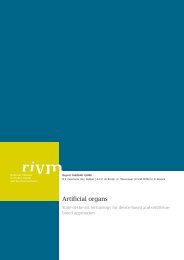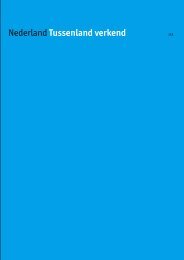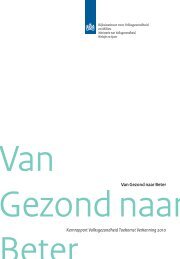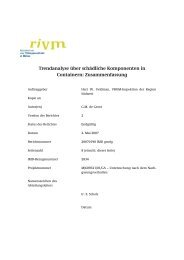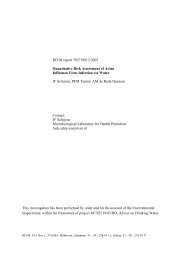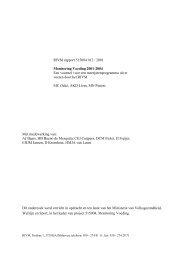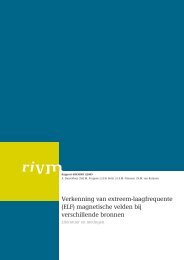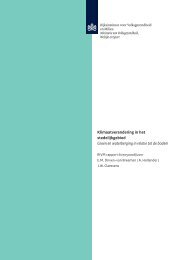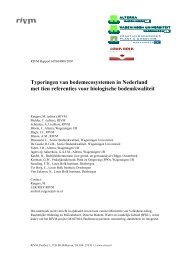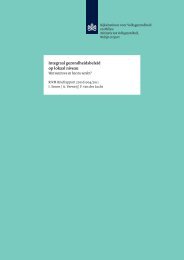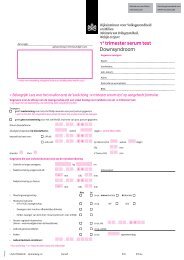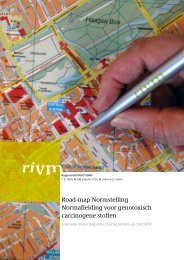RIVM report 607633001 EU-wide control measures to reduce ...
RIVM report 607633001 EU-wide control measures to reduce ...
RIVM report 607633001 EU-wide control measures to reduce ...
You also want an ePaper? Increase the reach of your titles
YUMPU automatically turns print PDFs into web optimized ePapers that Google loves.
Summary<br />
The Water Framework Directive requires Member States <strong>to</strong> implement the necessary <strong>measures</strong> in order<br />
<strong>to</strong> comply with environmental quality standards of Priority Substances or <strong>to</strong> cease or phase out<br />
emissions, discharges and losses of Priority Hazardous Substances. Cadmium is one of these Priority<br />
Hazardous Substances. In commission of the Netherlands Ministry for Housing, Spatial Planning and<br />
the Environment (VROM), the National Institute for Public Health and the Environment (<strong>RIVM</strong>)<br />
investigated the following questions:<br />
− What is legally regulated in international context and what nationally for emission <strong>control</strong> of<br />
cadmium? Have the Netherlands implemented the international rules?<br />
− Which <strong>measures</strong> have been taken at the national level in addition <strong>to</strong> the obliga<strong>to</strong>ry European<br />
legislation?<br />
− What is the present water quality and which emission sources are responsible for cadmium<br />
pollution in the Netherlands? Are the demands of the Water Framework Directive (WFD)<br />
regarding cadmium pollution fulfilled at present?<br />
− Will the Water Framework Directive-demands be fulfilled in time regarding water quality and<br />
emission of cadmium?<br />
− Which additional <strong>measures</strong> can be established at Community and at national level <strong>to</strong> reach water<br />
quality and emission demands for cadmium?<br />
A stepwise approach was followed. Firstly, possible <strong>measures</strong> <strong>to</strong> <strong>reduce</strong> cadmium discharge, emission<br />
or loss were identified within existing European directives and regulations. Secondly, Dutch legislation<br />
was checked for compliance with these European legislative texts. Existing gaps between European and<br />
Dutch legislation were identified by searching for present and past derogations and infringement<br />
procedures. The level of enforcement was determined by studying the <strong>report</strong>s of various inspec<strong>to</strong>rates<br />
and consultation of several experts. The information in the selected legislative texts was combined with<br />
previously established source identification for cadmium in Dutch surface waters <strong>to</strong> identify the most<br />
relevant and cost effective <strong>measures</strong> and the limitations. Possible alternative approaches for taking<br />
<strong>measures</strong> are discussed in the discussion section.<br />
European legislation was found <strong>to</strong> be fully implemented in national law and enforcement of the<br />
national law was covered. In addition <strong>to</strong> European requirements, the Netherlands have established<br />
supplementary <strong>measures</strong> <strong>to</strong> handle cadmium-pollution, such as the establishment of a Dutch Priority<br />
Substances-list. Cadmium is appointed as one of these Dutch Priority Substances. For these Priority<br />
Substances, emissions need <strong>to</strong> be <strong>report</strong>ed for all installations. Furthermore, Dutch law prescribes the<br />
application of best available techniques for all point sources and not only for Integrated Pollution<br />
Prevention Control-installations. Other <strong>measures</strong> are several subsidy programmes stimulating<br />
investment in environmentally friendly techniques.<br />
Main Dutch sources of cadmium-load <strong>to</strong> surface water were agriculture, sewage systems and sewering,<br />
atmospheric deposition and the industry. Approximately 75% of cadmium was imported via the<br />
international rivers.<br />
Emission sources not yet covered by international legislation (i.e. by the European Pollutant Release<br />
Transfer Registration) are the smaller combustion plants. A proposed Integrated Pollution Prevention<br />
Control-directive will add new categories of installations in the future, but will still not cover all<br />
installations. Moreover, the emission limits of the Integrated Pollution Prevention Control-directive are<br />
<strong>RIVM</strong> Report <strong>607633001</strong> 9



